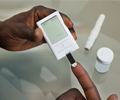Tag Archives: PCSK9 inhibitors

September 2018 Br J Cardiol 2018;25(suppl 2):S3 doi:10.5837/bjc.2018.s06
Introduction
Naveed Sattar
| Full textNovember 2017 Br J Cardiol 2017;24:129
NICE publishes updated familial hypercholesterolaemia guidance
BJC Staff
| Full text
February 2017 Br J Cardiol 2017;24:13 Online First
Innovations in cardiorenal medicine
Richard Crawley
| Full textMarch 2016 Br J Cardiol 2016;23:9
Confusing NICE guidance on PCSK9 inhibitors
BJCardio Staff
| Full textOctober 2015 Br J Cardiol 2015;22:138–142
News from the European Society of Cardiology Congress 2015
BJCardio Staff
| Full textMay 2015 Br J Cardiol 2015;22:59–60 Online First
News from the European Atherosclerosis Society Congress
BJCardio Staff
| Full text
July 2014 Br J Cardiol 2014;21:91–3 doi:10.5837/bjc.2014.021
New opportunities for cholesterol lowering: focus on PCSK9 inhibitors
Peter Sever, Judy Mackay
| Full text

